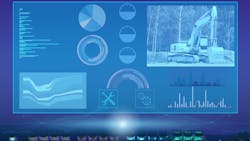How Machine Learning Could Aid the Design Process
Use of machine learning (ML) is on the rise in a range of industries and being put to use in various ways, including aspects of the design process.
But what exactly is machine learning? IBM describes it as a branch of artificial intelligence (AI) and computer science which uses data and algorithms to imitate the way humans learn. Training of algorithms enables calculations and predictions to be made and utilized to aid decision making. Over time, a machine can learn to create these algorithms itself with the overall goal of ML enabling faster problem solving and computation than a human.
With this capability, engineering teams could use ML to run through various design scenarios when developing a new product which could help to speed up the process.
This was the use case pointed out several times during the Society of Tribologists and Lubrication Engineers' (STLE) recent Virtual Symposium: Digital Tribology. The 2-day event offered presentations on various ML technologies and ways it is being used in industries, including the field of tribology — the study of friction, wear, and lubrication which looks at how interacting surfaces behave in relative motion.
Opportunities and Challenges with Machine Learning
A key point made throughout the STLE event was the potential machine learning could provide to help reduce the time and costs associated with investigating new materials or design options, as well as how they might be used in actual applications, by using computational tools and digital data.
One presentation during the STLE event was by a professor at Georgia Tech, Rampi Ramprasad, who is interested in improving the energy density of capacitors, common components in battery-electric vehicles. To do so, he is researching the potential for new polymer options which could help increase energy density without sacrificing other desirable performance aspects.
Typically, Ramprasad uses DFT — density functional theory, a modeling method for investigating the electronic structure of a system — to study polymer options. However, it can be a time consuming process.
So Ramprasad and his research team used data from the traditional DFT method, as well as physical research, to create machine learning models which could help speed up the process of evaluating polymer options. The team found machine learning could help the process, but collecting all necessary data to create predictive models poses its challenges as there is a lot of information out there. Aspects such as the lack of standard names for polymers requires more work on the front end to build into the models all possible names so different types of polymers are accurately identified.
READ MORE: How AI and ML are Revolutionizing Electronics Manufacturing
Data was the biggest challenge noted throughout the event with using ML for design or other work. Ramprasad noted that if there is not enough diverse data for the problem you're trying to solve, then it can be difficult to use machine learning.
Ashlie Martini, a professor at the University of California Merced, who spoke during the event about her use of ML for predicting lubricant properties agreed with the need for good data. She said good data, especially in the field of tribology, can be hard to find because aspects can change so frequently. Not that the data available in the field is bad, but it varies so much based on the environment, who is conducting the testing, etc. As such, she said the way tribology uses data is not easy to just put into ML algorithms.
Additional challenges pointed to include determining how best to present information in a manner that will be helpful for users. One presenter said the biggest stumbling block currently from his perspective is developing the software necessary to automate machine learning algorithms. He said this is a time consuming process that needs to be considered.
Another presenter said there will also be applications in which there will be a need to explain why the AI made the decisions it did, such as in medical applications or autonomous vehicles. As deep learning continues to progress, this will become an increasingly important factor to keep in mind.
READ MORE: Machine Learning Models Predict Compressed Air Anomalies
While there are many challenges associated with machine learning that have yet to be overcome in various industries, it is evident its use is growing and presents opportunities to benefit design and other aspects.
We want to hear from you!
How are you seeing machine learning entering the market? How are you using machine learning and what benefits are you seeing? What opportunities do you foresee through use of machine learning?
Let us know! Reach out directly via email [email protected] or on social media.
Twitter: @TechnlgyEditor or @PowerMotionTech
LinkedIn: @PowerMotionTech
About the Author
Sara Jensen
Executive Editor, Power & Motion
Sara Jensen is executive editor of Power & Motion, directing expanded coverage into the modern fluid power space, as well as mechatronic and smart technologies. She has over 15 years of publishing experience. Prior to Power & Motion she spent 11 years with a trade publication for engineers of heavy-duty equipment, the last 3 of which were as the editor and brand lead. Over the course of her time in the B2B industry, Sara has gained an extensive knowledge of various heavy-duty equipment industries — including construction, agriculture, mining and on-road trucks —along with the systems and market trends which impact them such as fluid power and electronic motion control technologies.
You can follow Sara and Power & Motion via the following social media handles:
X (formerly Twitter): @TechnlgyEditor and @PowerMotionTech
LinkedIn: @SaraJensen and @Power&Motion
Facebook: @PowerMotionTech

Leaders relevant to this article:

